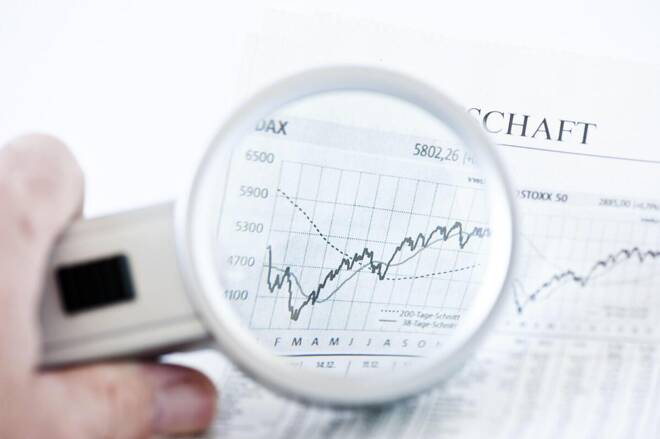Advertisement
Advertisement
DAX Index Forecast: Eurozone Data and Fed Speakers to Impact Market Sentiment
By:
Key Points:
- The DAX fell by 0.14% on Tuesday, ending the session at 17,068.
- On Wednesday, Eurozone consumer confidence numbers and ECB commentary warrant investor attention.
- Later in the session, Fed speakers and US corporate earnings will also need consideration.
Overview of the DAX Performance on Tuesday
The DAX fell by 0.14% on Tuesday. Following a 0.15% decline on Monday, the DAX ended the session at 17,068. Significantly, the DAX held onto the 17,000 handle for the fourth consecutive session.
China Economic Growth Jitters and Earnings Impact DAX Trends
On Tuesday, concerns about the Chinese economy tested buyer demand for riskier assets. The PBoC slashed the 5-year loan prime rate by 25 basis points to 3.95%. However, the markets patiently await fiscal stimulus from Beijing to bolster the economy.
Negotiated wage growth numbers for the Eurozone supported market bets on an April ECB rate cut. Softer wage growth could impact consumer spending and dampen demand-driven inflation.
US CB Leading Economic Index Offered Late Support
On Wednesday, the CB Leading Economic Index declined from +6 to -1 in January. Economists forecast an increase to +7. The unexpected fall drove buyer demand for DAX-listed stocks. However, the numbers had a limited impact on sentiment toward Fed interest rate goals.
The services sector, inflation, and the labor market remain focal points.
The Tuesday Market Movers
Concerns about demand pressured energy stocks. Siemens Energy AG slid by 4.07%. Fresenius SE was also among the worst performers, declining by 2.36%. Concerns about patient volumes pressured Fresenius Medical Care.
Registration numbers impacted auto stocks, which were among the worst performing. Porsche and Volkswagen ended the day down 2.00% and 1.58%, respectively. Mercedes-Benz Group and BMW declined by 1.26% and 0.97%, respectively.
Eurozone Consumer Confidence and the ECB in Focus
On Wednesday, consumer confidence numbers for the Eurozone will draw investor interest. Economists forecast the Eurozone Consumer Confidence Index to increase from -16.1 to -15.6 in February. A more marked increase could support an improving spending outlook.
However, investor sentiment toward ECB rate cuts remains the focal point before the private sector PMIs on Thursday. Investors must monitor ECB commentary. ECB Executive Board members Edouard Fernandez-Bollo and Anneli Tuominen are on the calendar to speak on Wednesday.
Views on the timeline for rate cuts could impact buyer demand for rate-sensitive DAX-listed stocks.
Corporate earnings will also move the dial. Fresenius SE is among the big names to release earnings on Wednesday.
FOMC Member Speakers, the Fed Minutes, and Earnings in Focus
On Wednesday, FOMC member speeches will warrant investor attention before the Fed Meeting Minutes.
FOMC members Raphael Bostic and Michelle Bowman are on the calendar to speak. Reactions to recent US inflation numbers and views on timelines to cut interest rates need consideration.
After the European closing bell, the Fed Meeting Minutes are out. Pre-release jitters could test market risk sentiment. Recent US inflation numbers have erased bets on the Fed cutting interest rates in March and May.
Beyond the economic calendar, corporate earnings will also be in focus. NVIDIA Corp. (NVDA) is among the big names to release earnings on Wednesday.
Short-term Forecast
Near-term trends for the DAX will likely hinge on central bank commentary and service sector PMI numbers. Softer service sector PMIs could force the ECB to take a more dovish stance on interest rates. Rising bets on an April ECB rate cut could support the appetite for DAX-listed stocks.
On Wednesday, the DAX futures and Nasdaq mini were down 11 and 48 points, respectively.
DAX Technical Indicators
Daily Chart
The DAX remained well above the 50-day and 200-day EMAs, confirming the bullish price trends.
A DAX return to the 17,100 handle would bring the Friday all-time high of 17,199 into play. A breakout from the Friday high would support a move to the 17,250 handle.
On Wednesday, euro area data, central bank commentary, and corporate earnings need consideration.
However, a break below the 17,000 handle would support a fall toward the 50-day EMA.
The 14-day RSI at 59.58 indicates a DAX move the ATH 17,199 before entering overbought territory.
4-Hourly Chart
The DAX hovered above the 50-day and 200-day EMAs, confirming the bullish price trends.
A DAX move to the all-time high of 17,199 would give the bulls a run at the 17,250 handle.
However, a drop below the 17,000 handle would bring the 50-day EMA into play.
The 14-period 4-hour RSI at 55.15 suggests a return to the all-time high of 17,199 before entering overbought territory.
About the Author
Bob Masonauthor
With over 28 years of experience in the financial industry, Bob has worked with various global rating agencies and multinational banks. Currently he is covering currencies, commodities, alternative asset classes and global equities, focusing mostly on European and Asian markets.
Advertisement
